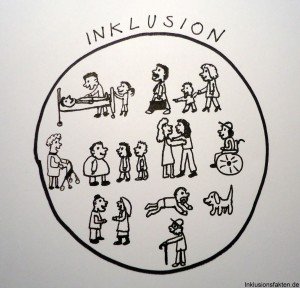About myths and facts about inclusion
Here, a look at research helps to understand that this statement is incorrect (Research results_GU). The studies show that children in joint classes do not get worse, sometimes even better results. Because of the inclusive D >
- "Children with no disabilities are just as good as pupils in classes without joint classes, in some studies they even achieve better results than in non-integrative classes (Feyerer 1998; Preuss-Lausitz 2009; Wocken 1999)", (Demmer-Dieckmann).
- "Even particularly gifted children with an IQ greater than 117 are not hindered in their cognitive development and are additionally supported in their social skills (Bless / Klaghofer 1991; Feyerer 1998)", (Demmer-Dieckmann).
- The performance heterogeneity in a class does not matter for performance development (cf. DESI 2006, p. 52).
- Brain researcher Hüther: "Integration makes you smart"
Inclusion and performance are not mutually exclusive
If children with different learning requirements learn together, there are no disadvantages. The study “German English Student Achievements International” (DESI) showed:
"Another characteristic of the class context, performance heterogeneity, does not turn out to be a risk factor, but rather irrelevant for performance development."(DESI 2006, p. 52).
The teachers’ union GEW says:
"According to the study, another belief in German school policy has been empirically refuted, namely that more is learned in classes with equally high-performing students than in those with a wide range of performance”(GEW 2006).
Nevertheless, the illusion of the homogeneous learning group will maintain certain representatives. It is correct that a class in which the pupils have different learning levels (e.g. a pupil with a high level of talent already solves tasks from higher classes and a pupil with Down syndrome writes his first words) does not learn any worse than classes in which that is not the case. In many cases it has been observed that the classes in which pupils with special needs also learn achieve better results than classes in which there are no children with disabilities. A high school class in Hanover in which there was a student with Down syndrome performed better than the comparison classes in which there were no students with disabilities (see also interview Deutschlandradio Kutur 2014 and Zeit-Artikel 2014). The reason for this is the differentiation by which a gifted child is also better supported. The inclusive didactics with their cooperative forms of work, the individual support of all children, through the 2-teacher system (special educator and subject teacher) and the classroom climate have a positive effect on the learning processes of all children. All children benefit from inclusive education, provided the necessary resources are available:
“We have learned a lot from the special educators how to organize our lessons differently. What is good for children with disabilities, especially vivid learning, is also good for everyone else.“(Schöler 2009, in: Inclusion and high school legal aspects scientific knowledge. Kassel, February 6, 2012, Dr. Clemens Hillenbrand, University of Oldenburg).
Learning together promotes social skills, tolerance and a sense of recognition. A welcome structure in inclusive settings contributes to a fear-free climate, because every child is welcome there with its diversity. Children who are afraid of "staying seated", having to change school or failing to learn badly. Children who are afraid cannot absorb the substance. This applies to children with and without special educational needs.
In the inclusive or integrative class, it is assumed that the class is hetrogenic. The aim is that all pupils can learn individually, regardless of the label "special educational needs" – the highly gifted as well as the child with so-called severe multiple disabilities (elementary learning needs). All children have special needs.
"The requirement that the" individual support needs "of all pupils who are considered disabled or not disabled in a school can be satisfied for everyone is a fundamental concern for a lesson described under the term" integration ". Its redemption clearly goes beyond an integration term in the specified narrow sense. In a general way, it takes classes in classes, the heterogeneity of which is not only due to "disabilities", different levels of development and learning outcomes of the students, but also due to their different language, religion, nationality and culture " (Georg Feuser, 1999).
The different types of learning (visual, auditory, haptic, etc.) should be considered in the inclusive class as well as the individual learning pace and the emotional state of each child. Children who have problems or who are depressed do not learn well. The quality of the relationship between teachers and learners and the corresponding support offers play an important role here, which is taken into account by pedagogy. Learning in inclusive classes does not mean that a teacher is at the forefront and explains for hours. Through project work, learning at stations and other methods of inclusive didactics, the pupils not only learn specialist knowledge, but also cooperation and consideration. The teaching-learning effect that occurs when a child explains something to another child consolidates the child’s knowledge that has slipped into the teaching role.
"The scientific studies on the topic of individual support show that learning in heterogeneous learning groups can be effective for pupils with learning and performance difficulties as well as with performance levels or special learning potential. The first group develops their professional skills, while the second group benefits above all in the area of social skills. In the sense of a democratic understanding of education with the aim of social participation, these results are to be assessed as positive“(Individual support as a school challenge from Christian Fischer with the collaboration of: David Rott, Marcel Veber, Christiane Fischer-Ontrup & Angela Gralla, Friedrich Ebert Foundation 2014, p.15).

I myself never saw my classmates with disabilities as a disadvantage, but as a great advantage (also with regard to the quality of the lessons). (See also: Tagesspiegel article: What non-disabled people can learn from disabled people 2014). Mrs Prof. Dr. Kerstin Merz-Atalik and others also believe that non-disabled students should also be given the opportunity to experience people with disabilities.
Different people respond here (as part of the Inclusion campaign) on the Question whether non-disabled children learn less in inclusive lessons.
Various statements made by these Austrian students show that schoolchildren rate the joint lessons positively:
Feyerer, E. (1998): Do Disabled People Disabled? Integrative teaching in lower secondary level Innsbruck / Vienna.
Hüther G (2008): Why does integration make you smart? In: mittendrin e.V. (ed.) A school for everyone. Books on Demand GmbH publishing house, Cologne, 311-313.
Kultusminister der Länder, ed. (2006): Teaching and skills acquisition in German and English. Central findings of the study German English School Achievements International (DESI). A study commissioned by the Ministers of Education for the Länder in the Federal Republic of Germany, Frankfurt am Main.
RELATED ITEMS
-

Primary schools, city of koblenz
The primary school is divided into grades 1 to 4 and the children are usually between six and ten years old. Class starts in…
-

Cooperation between kindergarten and primary school
Orientation area (jump marks) The education portal: School system School system Basics School types Elementary school Language level assessment Transition…
-

Common household chemical can increase children’s eczema
Exposure to a household chemical in the womb can increase children’s eczema, a new study suggests. In the study, mothers exposed…
-

Simple games for english lessons (10): living memory, primary school snoop blog
Especially in foreign language initial lessons, simple methods and games are required to get children excited about the foreign language. A row of…
